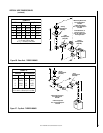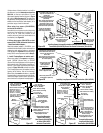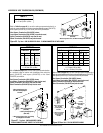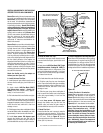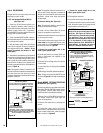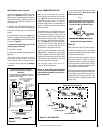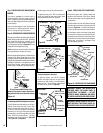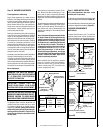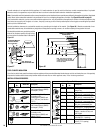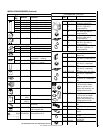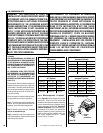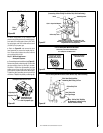
22
NOTE: DIAGRAMS & ILLUSTRATIONS NOT TO SCALE.
Figure 52
Electronic Appliance Checkout
To light the burner, turn ‘ON’ the optional
remote wall switch and turn the gas control
switch to the “ON” position. Ensure the ignitor
lights the pilot. The pilot flame should engulf
the flame rod as shown in
Figure 52
.
ELECTRONIC
Proper Flame
Adjustment
Pilot
Nozzle
3/8 To 1/2 Inch
(9 mm to 13 mm)
Ground
Electrode
Flame Rod
Hot Surface
Igniter
Latch
Latch
Glass Door
Firebox Floor
Bottom Vee-flange
Door Frame
Top Flange
Door Frame
Figure 53
- INSTALLING THE GLASS DOOR
Figure 49
Step 7. INSTALLING LOGS AND GLOWING
EMBERS
The logs are packaged in a carton which is
shrink-wrapped to the front glass enclosure
panel. The glowing embers are packaged sepa-
rately in a plastic bag located in the control area
of the fireplace.
WARNING: HANDLE THIS GLASS WITH
EXTREME CARE! THE GLASS PANEL IS
SUSCEPTIBLE TO DAMAGE — DO NOT
SCRATCH WHILE HANDLING OR WHILE
RE-INSTALLING THE GLASS DOOR FRAME.
WARNING: NEVER OPERATE THE APPLI-
ANCE WITHOUT THE FRONT GLASS EN-
CLOSURE PANEL IN PLACE AND SECURE.
Step 9. INSTALLING THE GLASS DOOR
Retrieve the glass door. Visually inspect the
gasket on the backside of the frame. Gasket
surface must be clean, free of irregularities and
seated firmly.
Position the door in front of the firebox opening
with the bottom of the door held away from the
fireplace
(Figure 53
). Hook the top flange of
the door frame over the top of the firebox frame.
Let the bottom of the door frame swing gently
in towards the fireplace ensuring that the gas-
ket seats evenly as the door frame draws shut.
Fasten the two latches located underneath the
firebox floor to the door's vee-flange. Close
both the latches securely.
Refer to the homeowner's care and operation
instructions for detailed placement instruc-
tions for the logs and glowing embers.
Sit and Honeywell Millivolt Gas Valve
Showing Piezo Ignitor Location (Each Unit is
Equipped with Only One of these Gas Valves)
Piezo
Ignitor
SIT Gas Valve
Honeywell
Gas Valve
Step 8. CHECKING APPLIANCE OPERATION
With gas line installed run initial system checkout
before closing up the front of the unit. Follow the
pilot lighting instructions provided in the
Homeowner's Care and Operation Instructions.
For piezo ignitor location see
Figure 49
(SIT and
Honeywell millivolt appliances only).
Note: Instructions are also found on the litera-
ture tag attached to the gas valve train.
When first lighting the appliance, it will take a few
minutes for the line to purge itself of air. Once
purging is complete, the pilot and burner will light
and operate as indicated in the instruction manual.
Subsequent lightings of the appliance will not
require such purging. Inspect the pilot flame
(remove logs, if necessary, handling carefully).
SIT and Honeywell Millivolt Appliance Checkout
The pilot flame should be steady, not lifting or
floating. Flame should be blue in color with
traces of orange at the outer edge. The top ³⁄₈"
(10 mm) at the pilot generator (thermopile)
and the top ¹⁄₈" min (tip) of the quick drop out
thermocouple should be engulfed in the pilot
flame. The flame should project 1" (25 mm)
beyond the hood at all three ports (
Figure 50
- SIT, Figure 51 - Honeywell
)
Replace logs if removed for pilot inspection.
To light the burner; turn “ON” the remote wall
switch and rotate the gas valve control knob
counterclockwise to the “ON” position.
Figure 50
Figure 51
¹⁄₈" Min
(3 mm)
Thermocouple
Ignitor Rod
Hood
³⁄₈" Min
(9 mm)
Thermopile
HONEYWELL MILLIVOLT
Pilot
Nozzels
SIT MILLIVOLT
Thermocouple
Hood Ignitor Rod
³⁄₈" Min
(9 mm)
Thermopile
Pilot
Nozzels



